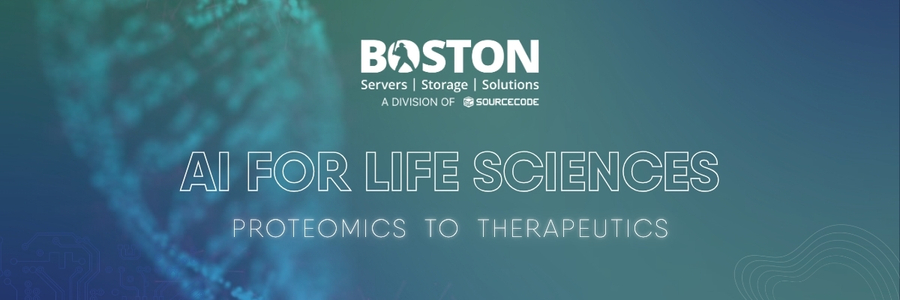
In modern biotech, the bottleneck is no longer the ability to generate data. Sequencers, mass spectrometers and high-throughput assays flood laboratories with terabytes daily.
The challenge is turning that raw biological noise into actionable insight
NVIDIA’s new generation of AI Factories, built on NVIDIA Blackwell™ GPUs, NVIDIA RTX™ 6000 PRO systems, and NVIDIA DGX SuperPOD™ infrastructure, are emerging as the engines that make such breakthroughs practical, transforming genomics, proteomics and therapeutic discovery into near real-time sciences.
Genomics and Proteomics: From Sequencing to Structure in Minutes
The genomics pipeline is notoriously data-intensive, requiring alignment, variant calling and annotation at scale. Traditionally, these workflows could take hours or even days, slowing research and clinical decision-making. Similarly, proteomics, characterising the full complement of proteins, their modifications and interactions, is inherently data heavy, generating enormous raw datasets, while protein structure prediction adds another layer of computational complexity.
By collapsing hours of computation into minutes, AI Factories powered by NVIDIA AI Enterprise™ and NIMs (NVIDIA Inference Microservices™) make population genomics, large-scale research and even clinical sequencing both financially and operationally viable. What once required centralised supercomputers can now be done routinely, accelerating precision medicine and enabling faster diagnostics.
Genomics Workflows
- NVIDIA Parabricks™ accelerates germline and somatic variant calling, alignment, and annotation. What once took hours or days now completes in minutes.
- NVIDIA Clara™ Parabricks and Clara Discovery extend genomic workflows into clinical pipelines and drug discovery, bridging the gap between sequencing and actionable insight.
- Population-scale studies become financially viable as data bottlenecks are removed, and throughput is maximised.
Proteomics Workflows
- AlphaFold 2, optimised for GPUs, predicts protein structures with breakthrough accuracy, reducing the gap between sequencing and structural insight.
- NVIDIA BioNeMo™ supports generative AI for protein design, antibody optimisation and molecular docking, accelerating drug discovery and biologics development.
- NIMs for NVIDIA BioNeMo™ enable rapid deployment of pretrained protein language models and molecular simulation tools, letting researchers integrate AI-driven predictions directly into their pipelines.
- Clara Discovery further supports proteomics workflows in imaging, structural biology and multi-omics integration.
Antibody Development: Designing Therapeutics at Speed
Therapeutic antibody development has long been slow and expensive, requiring iterative cycles of discovery, screening and optimisation. AI Factories radically compress this cycle:
- Sequence-based models trained on massive datasets can predict binding or neutralisation activity but require immense computational power for training and inference. NVIDIA Blackwell™ GPUs make this feasible.
- Frameworks such as ImmunoAI leverage 3D structural and physicochemical features to refine binding affinity predictions, reducing the experimental search space dramatically.
- Structure prediction models, such as OpenFold and AlphaFold derivatives, run tens to hundreds of times faster on NVIDIA Blackwell™ GPUs, enabling in silico modelling of antigen–antibody interactions before laboratory validation.
- Libraries of thousands of candidate antibodies can be computationally screened and filtered within days, not months.
The outcome is a dramatic reduction in cost and timeline for therapeutic antibody discovery, and crucially, greater readiness for emerging infectious diseases.
What Makes NVIDIA's AI Factories Tick
| Component | Role | Contribution in Biotech |
| NVIDIA Blackwell™ Architecture (GPUs + Grace™ CPUs, NVLink™, decompression engines) | Latest generation designed for high throughput, new precision modes, and vast memory | Keeps full genomics and proteomics pipelines GPU-resident; enables ultra-fast structure prediction and variant calling |
| NVIDIA DGX™ SuperPOD | Scalable clusters of GPUs with high-speed interconnect and Grace CPUs | Supports multi-omics workloads at population scale; ideal for model training and massive inference |
| NVIDIA RTX™ 6000 PRO Blackwell Server Edition | Enterprise-ready GPU | Perfect for smaller laboratories needing accelerated genomics or proteomics workflows without full SuperPOD investment |
| NVIDIA Parabricks™ and optimised software stack | GPU-accelerated genomics and proteomics tools | Shrinks pipelines from hours or days to minutes |
| Networking and BlueField™ DPUs | High-throughput I/O and data management | Essential for handling terabyte-scale genomics and proteomics datasets efficiently |
Conclusion
NVIDIA’s AI Factories, built on NVIDIA Blackwell™, NVIDIA DGX™ SuperPOD and NVIDIA RTX™ PRO infrastructure, are not just speeding up computation, they are redefining what is scientifically possible. Genomics pipelines collapse into minutes, proteomics scales to entire proteomes and antibody discovery enters the era of in silico design loops.
For biotech, the question is no longer if these tasks can be done, but how quickly and accurately. With AI Factories, the age of reactive biomedical science is giving way to an era of anticipatory, precision-driven discovery.
FAQs
Genomics
Why is AI critical in genomics?
A: Traditional genomics pipelines can take hours to days, slowing clinical decision-making and population-scale studies. AI frameworks like NVIDIA Parabricks™ accelerate workflows (variant calling, alignment, annotation) from hours to minutes, enabling rapid insights at scale.
How does NVIDIA AI Enterprise support genomics research?
A: It provides an optimised, secure platform for running genomics AI workloads on NVIDIA GPUs, integrating Parabricks, Clara, and NIMs for reproducibility, scalability, and enterprise-grade support.
Proteomics
How is AI transforming proteomics?
A: AI enables fast and accurate protein identification, quantification and structure prediction. Tools like AlphaFold 2 predict 3D protein structures in hours, while BioNeMo™ applies generative AI for protein language modelling and molecular docking.
Can proteomics workflows be integrated with genomics?
A: Yes. Frameworks like Clara Discovery and NIMs allow seamless integration of genomics and proteomics data, enabling multi-omics research and accelerating translational medicine.
Antibody Development
What role does AI play in antibody design?
A: AI models trained on protein sequences and structures can generate candidate antibodies, predict binding affinities and optimise properties such as stability and specificity, dramatically reducing experimental cycles.
Which NVIDIA tools support antibody development?
A: BioNeMo™ provides pretrained and customizable protein language models for antibody engineering. Through NIMs, these models can be deployed as secure microservices, making advanced antibody discovery accessible to both biotech startups and large pharma.
What’s the biggest impact for industry?
A: By combining genomics (to identify targets), proteomics (to understand protein function) and AI-driven antibody design (to generate therapies), organisations can shorten R&D timelines, lower costs and bring precision medicines to market faster.